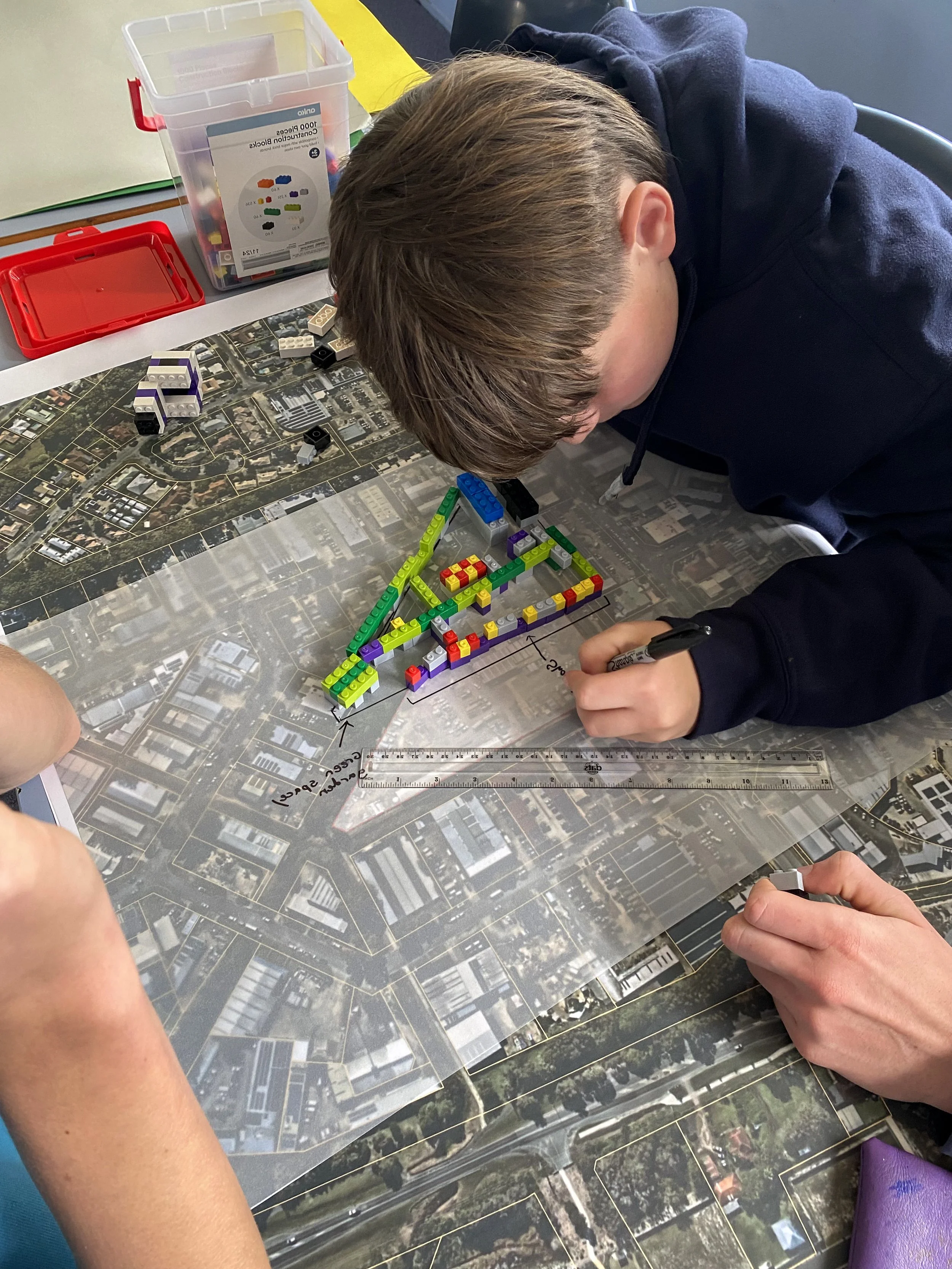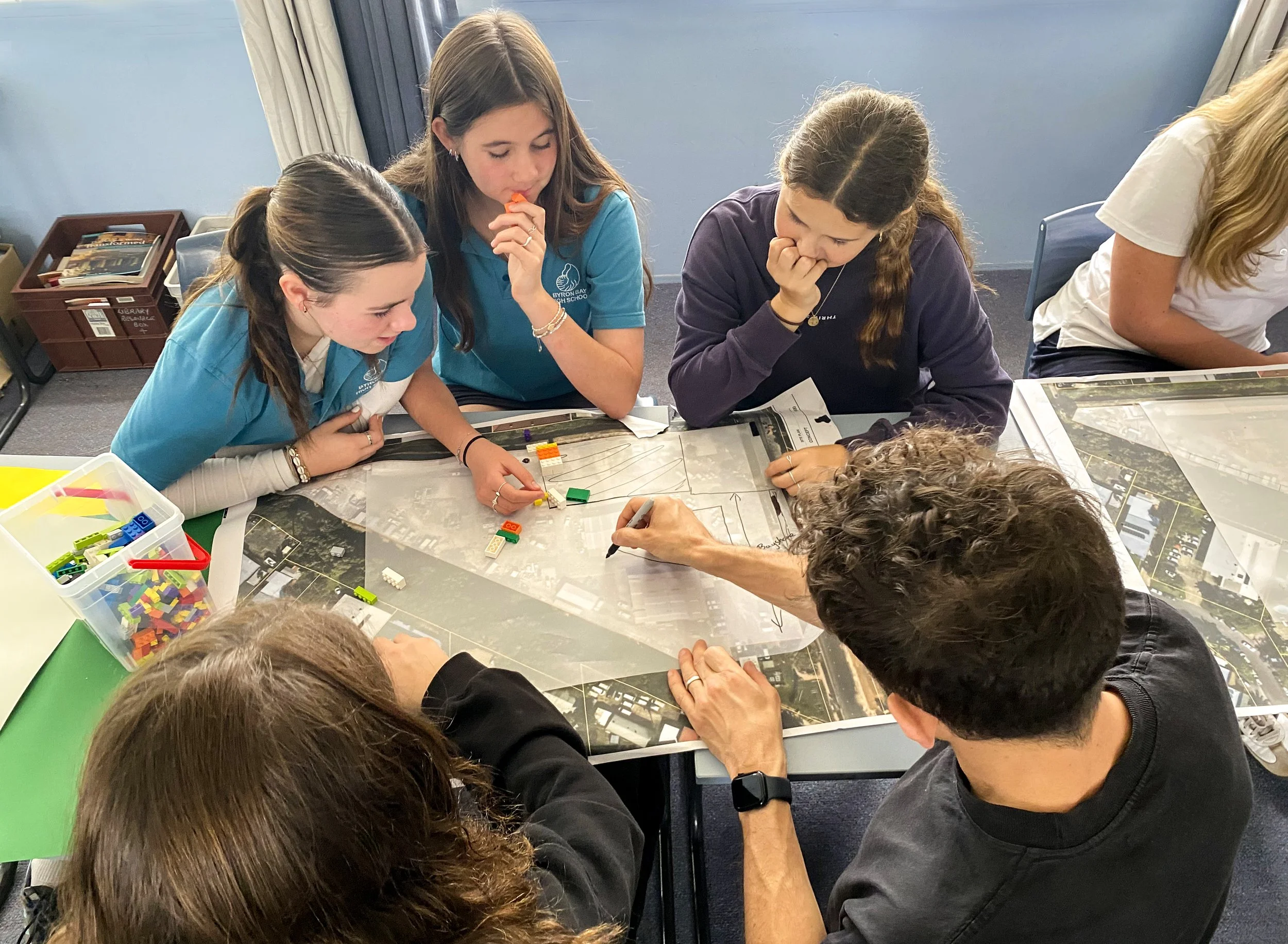New & Old School.
A CHAT WITH FRASER & STUART GALLETLY-SALISBURY
When it comes to future planning, too many chunks of the community don't get to contribute. Like our youth, even though they're the ones most affected.
Which is why Fraser Williams-Martin, Editorial Director of NOW (and Creative Director for Creative Capital) accepted the challenge of leading an urban design class for the senior geography students at Byron High.
A chat with Fraser & Stuart Galletly-Salisbury, local teacher and resident, about the workshop and the future of Byron.
_________
Stuart, what inspired you to organise an urban planning workshop for your class?
Stuart: After reading New Old Ways I was keen to help promote the ideas in the book, especially in my role as a teacher. So, I contacted Fraser, who was so approachable and enthusiastic. He's such a great advocate for community engagement.
What were you both hoping to achieve?
Stuart: I wanted students to gain insight into work that challenges the status quo and how an architect might contribute to that. I also wanted to highlight the real-world application of some of the theories we'd covered in class about urban places and how a regional town might address some of its challenges.
Fraser: I thought the voice of young people had been absent for a while locally, so I was keen to get a younger generation involved in the NOW concepts. Kids are often the smartest because they have such great ideas, so I was especially interested in hearing their thoughts.
Also, Byron is at a crossroads, where it'll either become a rich kids’ playground or a more interesting version of itself. I’m trying to steer it in a better direction, but I wanted to make students think about the fact that this is their Shire and their future. What do they want? Do they want to stay here? What’s the reality of staying here going to look like?
Connecting kids to the process of urban design and giving them a basic understanding of it means they can start to look at their home through a different lens and begin to dream of their future differently.
What did you get the kids doing?
Fraser: We started at Habitat in Byron as an example of good urban planning and designing. We discussed purpose-built and mixed-use development, and the benefits of designing a space to meet multiple needs like housing, commercial space, and recreational activities while fostering community.
Then, we headed outdoors to visit the Arts & Industry Estate in Byron, which is a gem of a place, but not really fit for its current purpose. While walking around, we discussed what it was intended for, how it’s used now, and the factors contributing to its current use.
We chatted about why local businesses were being pushed out of town, and ran through the estate's good, bad, and ugly aspects. We talked about everything, including how cool it is having panel beaters next to surfboard shapers next to fashion houses, to the lack of parking, trees, and footpaths, to drainage issues, thermal issues within the buildings, and the points of movement, privacy, work, and communal space.
While we were there, we looked at the Council Depot, and I asked the students to consider how they might redesign that space based on the founding principles of urban design and how the A&I Estate is used.
Later, the kids had a session with Stuart, before I returned to the classroom to complete the workshop, which included redesigning the Council Depot site. I gave the students Lego, paper, and pencils and they had to share their designs with the class.
Why focus on Byron's Arts & Industry Estate?
Fraser: The industrial estate is an interesting place for so many reasons. It’s a truly local part of Byron, filled with local creatives and entrepreneurs. It’s a space that's meaningful now and will continue to be meaningful for the future of the Shire.
Everyone wants to live in Byron, but the reality is there’s not much work, so most people who live here have to develop their own businesses. The A&I Estate is home to a high portion of those businesses, those people, and those dreams. The trick will be balancing current needs with future ones, and not losing the soul of the place by over gentrification and squeezing people out.
How did the students respond to the challenge?
Stuart: I was surprised by the variety of ideas they had. They were allowed the time and freedom to express themselves and created innovative solutions to existing problems that I hadn’t considered. The students loved the combination of construction using Lego and drawing.
Fraser: The kids came up with such brilliant solutions, it was great to see. My favourite response was from some kids who took an environmentally conscious approach and decided the Council Depot should be turned into a park. They envisioned a walking loop around the park with a bush tucker trail, native landscaping, and a water pond. I thought it was a beautiful idea that would give the estate a connected gathering spot.
Did either of you learn anything from the workshop?
Stuart: It reaffirmed the generosity of people in our region who are willing to give their time to students. Also, that change takes time and requires people to push the limits of creativity and be uncomfortable. Lastly, we learned that some innovative ideas will not please everyone and disagreements aren’t personal attacks.
Fraser: I learnt that kids are way more intelligent than we give them credit for and are so fast at making new connections and understandings. They’re also mostly free from baggage, so they can have really authentic conversations.
What are your hopes for the future of Byron?
Stuart: I hope to see greater support for young people to participate in society in new ways that emphasise the valuable interactions of land and community, yet afford them a comfortable lifestyle. I hope Byron continues to attract and accommodate people who are chasing a dream and wanting to participate in the community.
Fraser: I don’t want the weird and wonderful people to move out. I know change is inevitable, and it can’t be what it was "back in the good old days" but I want the place to retain and attract interesting people. I also want it to maintain the beautiful environment, to be able to weather the storms, and become an exemplar of planning done right and become the best version of itself.
A word from the students! In the spirit of handing our youth the mic, NOW checked in with the class about their experience…
_________
What did you think of the workshop?
We were grateful to get the opportunity because young people under 18 aren't actively consulted about the future of the town and issues that impact us.
The workshop provided us with awareness of the lack of green spaces and walkways for people in the industrial estate. It opened our eyes to how urban places look and how poorly maintained the drains and waterways are. We look at urban places differently now.
The assignment was challenging but enjoyable, particularly the real-world problem-solving we had to do. We liked the combination of fieldwork and theory to inform the design solutions and help us understand that things like this don’t operate in isolation, they all link and flow into the nearby areas.
What are your hopes for the future?
When we think of our future, we mostly aim to finish school, move away to study, but then return to Byron. We love Byron Bay. We want to contribute to improving the world in some way.
We hope older generations will take more responsibility for their actions through improved education and awareness of global warming, climate change, urbanisation and consumption. We want older generations to be involved in change that benefits the next generation.
What about the future of Byron Bay?
We want a more sustainable future. We want a tight-knit community with more green spaces and less dependence on fossil fuels. We don’t want a Byron that’s super-gentrified. We want locals to be able to stay here and for Byron to retain its unique culture and independent businesses.
We want the government to take more care of the environment. We want less litter, more bins, less consumption and fewer single-use plastic items available.
We want a maintained connection to the beach with no more hotels.
We want houses for residents instead of tourists.
We want greater funding and fairer wealth distribution for public schools to improve opportunities and facilities, links to Indigenous culture, connection to communities, and innovative practices that link the outside world to learning in school through more interaction with employers and opportunities in the community. ▲








